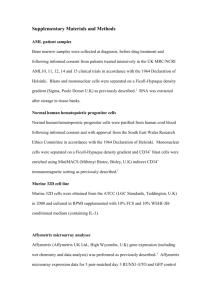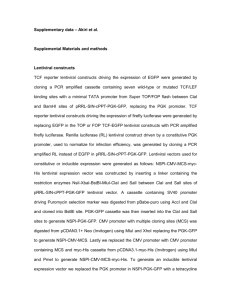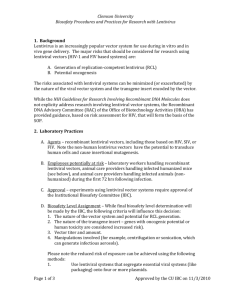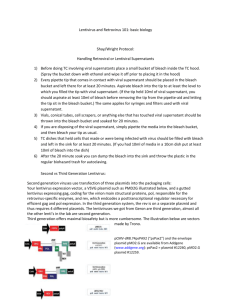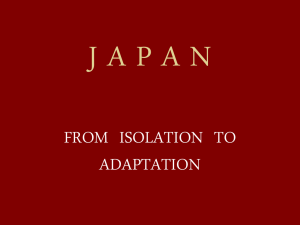Supplementary material (doc 112K)
advertisement
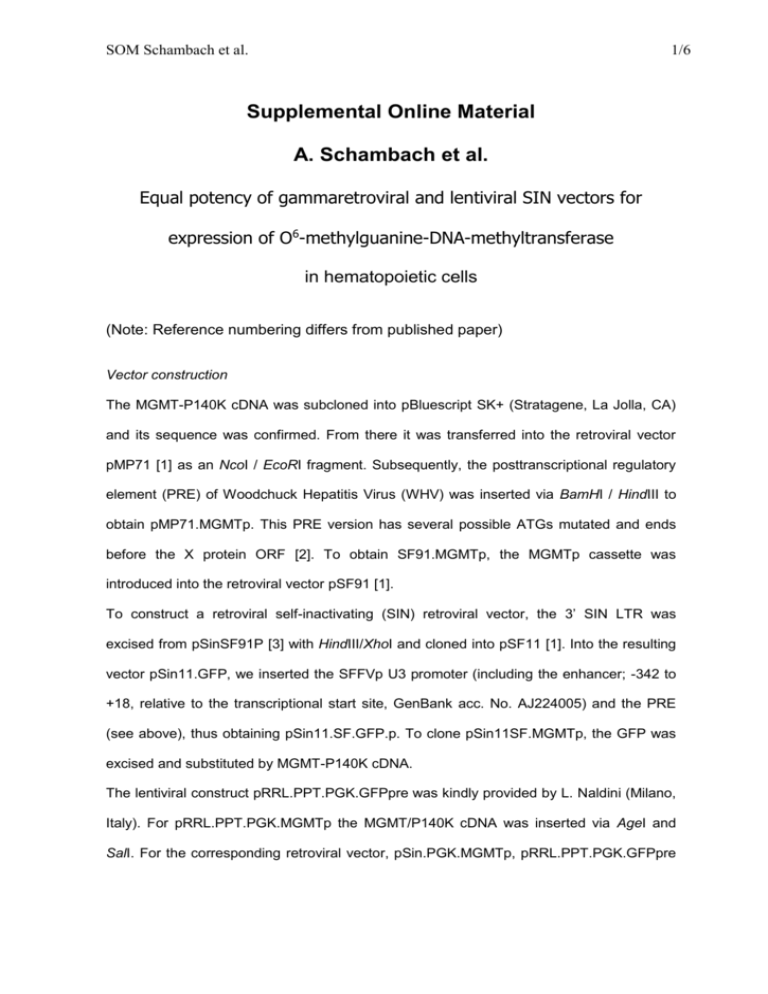
SOM Schambach et al. 1/6 Supplemental Online Material A. Schambach et al. Equal potency of gammaretroviral and lentiviral SIN vectors for expression of O6-methylguanine-DNA-methyltransferase in hematopoietic cells (Note: Reference numbering differs from published paper) Vector construction The MGMT-P140K cDNA was subcloned into pBluescript SK+ (Stratagene, La Jolla, CA) and its sequence was confirmed. From there it was transferred into the retroviral vector pMP71 [1] as an NcoI / EcoRI fragment. Subsequently, the posttranscriptional regulatory element (PRE) of Woodchuck Hepatitis Virus (WHV) was inserted via BamHI / HindIII to obtain pMP71.MGMTp. This PRE version has several possible ATGs mutated and ends before the X protein ORF [2]. To obtain SF91.MGMTp, the MGMTp cassette was introduced into the retroviral vector pSF91 [1]. To construct a retroviral self-inactivating (SIN) retroviral vector, the 3’ SIN LTR was excised from pSinSF91P [3] with HindIII/XhoI and cloned into pSF11 [1]. Into the resulting vector pSin11.GFP, we inserted the SFFVp U3 promoter (including the enhancer; -342 to +18, relative to the transcriptional start site, GenBank acc. No. AJ224005) and the PRE (see above), thus obtaining pSin11.SF.GFP.p. To clone pSin11SF.MGMTp, the GFP was excised and substituted by MGMT-P140K cDNA. The lentiviral construct pRRL.PPT.PGK.GFPpre was kindly provided by L. Naldini (Milano, Italy). For pRRL.PPT.PGK.MGMTp the MGMT/P140K cDNA was inserted via AgeI and SalI. For the corresponding retroviral vector, pSin.PGK.MGMTp, pRRL.PPT.PGK.GFPpre SOM Schambach et al. 2/6 was cut with EcoRV and SalI to excise the PGK promoter and the GFP. In a second step, the GFP cDNA was replaced by MGMT-P140K. To design pRRL.PPT.SF.MGMTp and pRRL.PPT.SF91.MGMTpre, the SFFVp promoter (see above) alone or the SFFVp promoter followed by a retroviral intron was excised from pSSF91P [3] and cloned into the lentiviral constructs. For pRRL.PPT.EF1.MGMTp the EF1 (intron-containing) promoter was excised from pHR’ EF1 EGFP (kindly provided by S. Karlsson, Lund, Sweden). To obtain pRRL.PPT.EFS.MGMTp, containing an EF1-promoter without an intron (EFS, EF1 short), primers 5’EFSnotcla (5’ CTTAGCGGCCGCATCGATTGGCTCCGGTGCCCGTCAGT 3’) and 3’EFSeco47bam (5’ CGATAGCGCTGGATCCCGCGTCACGACACCTGTGTTCTGGCGGCAAA 3’) were used to amplify a 240 bp EFS PCR product (template pRRL.PPT.EF1.MGMTp). This was cloned as a BamHI/ClaI fragment into pRRL.PPT.EF1.MGMTp to substitute for the longer version of the EF1 promoter. The EFS PCR fragment cut with NotI and Eco47III was used to obtain the retroviral counterpart, pSin.EFS.MGMTp. To construct pRRL.SFLTR.MGMTp, a Bst1107I site was introduced into the U3 deletion of the 3’ LTR at -3 (relative to the R region) by overlap-PCR. The SFFVp U3 was amplified via Pfu-PCR from pSSF91P (see above) using primers 5’SFFVU3blunt (5’ GCTAGCTGCAGTAACGCCATTTTGC 3’) and 3’SFFVU3blunt (5’ CAAGCAAAAAGCAGCTGCTTATAGAGCTCGGGAAGCAGAAGCGC 3’) and cloned into the opened Bst1107I site. All PCR products were sequenced. Production of vector supernatants, titrations, and transduction of cell lines Phoenix gp packaging cells (kindly provided by G. Nolan, Stanford) and 293T cells were used for retroviral and lentiviral supernatant production, respectively. Phoenix gp, 293T and SC1 cells were maintained in Dulbecco’s modified Eagles medium (DMEM) supplemented with 10% FCS, 100 U/ml penicillin/streptomycin, and 2 mM glutamine. SC1 SOM Schambach et al. 3/6 cells were grown in the latter mentioned medium. 32D cells were kept in RPMI, 10% FCS, 100 U/ml penicillin/streptomycin, 2 mM glutamine and 3 ng/ml IL-3 (Peprotech, Rocky Hill, NJ). The day before transfection, 5x106 Phoenix gp or 293T cells were plated on a 10-cm dish. For transfection, the medium was exchanged and 25 µM chloroquine (Sigma-Aldrich) was added. 8 µg transfer vector DNA, 1 µg of a GFP reporter plasmid to determine transfection efficiencies, and 2 µg of an ecotropic envelope plasmid [4] were used. In addition, 10 µg of retroviral gag/pol plasmid (M57) or 12 µg of a lentiviral gag/pol plasmid (pcDNA3 g/p 4xCTE) were transfected using the calcium phosphate precipitation method. When using lentiviral vectors, 5 µg of a Rev plasmid (pRSV-Rev, kindly provided by T. Hope, Chicago) was cotransfected. For the transduction of human cells, 5 µg of a RD114/TR envelope plasmid [5] (containing an amphotropic cytoplasmic tail, kindly provided by F. L. Cosset, Lyon) were used to pseudotype retro- and lentiviral vectors. Medium was changed after 10-12 h. Equal transfection efficiency was controlled by FACS analysis. Supernatants containing the viral particles were collected 24-72 h after transfection, filtered through a 0,22-µm filter, and stored at -80°C until usage. SC1 or 32D cells (5x104 – 3x105) were transduced by centrifugation for 60 min at 2000 rpm at 32°C in the presence of 4 µg/ml protamine sulfate (Sigma-Aldrich). After transduction, cells were grown for 4-5 days and subsequently analyzed by flow cytometry, fluorescence microscopy, western blot, and northern blot. Titration of the vector supernatants on SC1 cells was performed as previously described [3]. SOM Schambach et al. 4/6 Supplemental data to Figure 3A. Column chart of FACS data obtained with transduced 32D cells. The percentage of transduced cells (□) and the mean fluorescence intensity (MFI) of MGMT (■) were calculated and are shown for all vectors. Errors bars indicate standard deviations of 2 experiments. Data were reproduced in 2 different experiments (data not shown). SOM Schambach et al. Supplemental data to Figure 3. Kinetics of methyl transfer to wild type (Raji, 5/6 ■) and P140K mutant (RRL.SFLTR-transduced 32D cells, ♦, dashed line) protein. MGMT activity is given as percentage of maximum activity (at 4h). See Materials and Methods for details. Similar data were obtained in transduced human K562 cells (Figure 4D). SOM Schambach et al. References of supplemental material 1. 2. 3. 4. 5. Schambach, A., et al. (2000). Context dependence of different modules for posttranscriptional enhancement of gene expression from retroviral vectors. Molecular Therapy. 2: 435-445. Egelhofer, M., et al. (2004). Inhibition of HIV-1 entry in cells expressing Gp41derived peptides. J Virol. 78: 568-575. Kraunus, J., et al. (2004). Self-inactivating retroviral vectors with improved RNA processing. Gene Ther. 11: 1568-1578. Morita, S., Kojima, T., and Kitamura, T. (2000). Plat-E: an efficient and stable system for transient packaging of retroviruses. Gene Ther. 7: 1063-1070. Sandrin, V., et al. (2002). Lentiviral vectors pseudotyped with a modified RD114 envelope glycoprotein show increased stability in sera and augmented transduction of primary lymphocytes and CD34+ cells derived from human and nonhuman primates. Blood. 100: 823-832. 6/6
